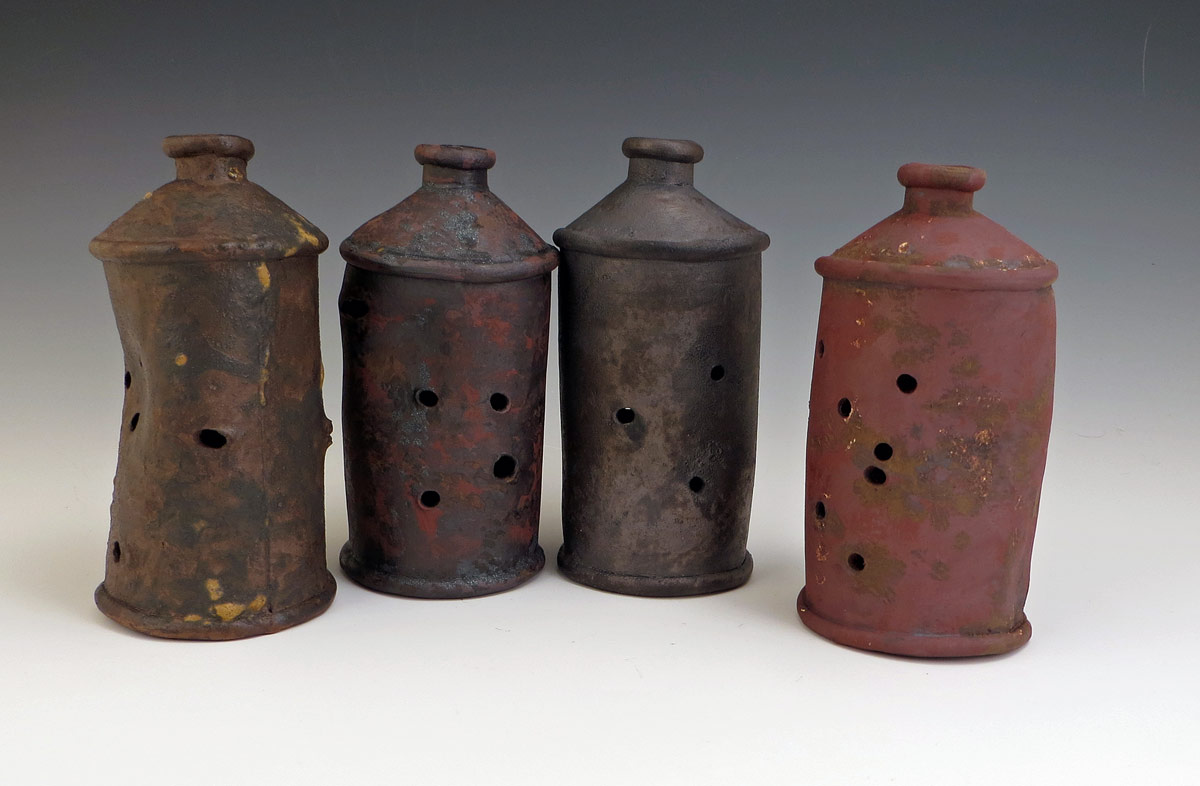
Usually my ceramic conetop beer cans delight. People marvel and touch. They tell me their beer can stories. They take them home to their mantels, dens and patios. Yet in truth not all go along with my artistic ruse. I find it’s nearly always because they are avid collectors of real metal vintage beer cans, and can’t abide my ceramic interpretations. I call these guys The Beer Can Police and my work has been variously described by them as “fake,” “pretty bizarre,” and “weird beer can art.”
What follows are two instances where I got a chance to reply to their misguided objections and stick up for myself with kindness and perhaps a lil bit of schooling.
“Unfortunately most of those are fake”
My ceramic conetop beer cans inadvertently challenge serious beer can collectors, especially in the realms of Perfection and Authenticity. I stick to neither.
I get it. I appreciate their search for their Holy Grail: that rare but gen-u-wine vintage can in perfect condition. When they see what I create, rust, dents and all, I can imagine it might grate on the purists. But with a wee bit of jolly understanding it doesn’t have to. And I can help with that.
When my artwork was called out on Facebook last May during my “99 Cans of Beer on The Wall Exhibit” as being “fake” because “the majority of them were never produced in that style of can,” I needed to gently educate about art. Here’s a bit of what I replied:
“…I realize they are not “historically accurate” but are my artist’s interpretation and homage to the excellence of labeling and to the conetop can, which is SO much more interesting than a plain cylinder. The beer can collectors (are you one by any chance?) have a hard time with me! I am curious about your use of the word fake…”
No reply was made, but that’s OK. I just couldn’t settle with being called a phoney when measured with the wrong yardstick!
“I could do that with a Sharpie”
I am a member of the Brewery Collectibles Club of America (in self-defense, but that’s another story) and a bonus of membership is their well-written and researched print magazine “Beer Cans and Brewery Collectibles.” It abounds with resources even for me, a non-collector. There are great photos, articles about searching for vintage cans (called “dumping”), histories of oldtime breweries, and a great classified ad section. There are lively CAN-ventions and chapters all over the US. Beer can collecting was really big in the 1970s, died down to the hardcore collectors after, but has never really faded. It is enjoying a bit of a renaissance with the aid of the internet.
One BCCA member stumbled upon my beer cans in my Etsy Shop last year and did not quite know what he was looking at. He, too, was understandably applying the Procrustean Measure of Perfection and Authenticity, and felt my art came up short. As a matter of fact, when he shared it to his chapter’s forum he claimed he could do as well. With a Sharpie!
Um, short answer: NO!!!!!
I gathered my gumption, joined the forum and wrote my best quavery-fingered reply:
My artistic goal is not to replicate beer cans, but to speak to their arrested decay: how do the lithographics, the structure, the metal fail and how to express that with clay and underglaze materials in a completely fired to over 2000 degrees surface? I realize it might rub a serious can collector quite the wrong way! I aim for a fool-the-eye approach that is loose and impressionistic and not a realistic report on a can…To be honest, I winced at the Sharpie reference, but I DO know that what you’re seeing is what I intended to put there, roughness and all…We love the same thing, just in different ways.
With that, and some continued honest dialogue, we put our differences to rest. Until next time, Peace Out.
–Liz Crain, who cannot find the exact words or the author for this half-remembered quotation, but it still fits: “Every man is an expert in something. The connoisseurs of boiling potatoes are legion.” Anyone know who said this? E-mail me!